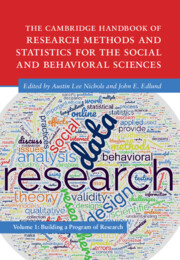 The Cambridge Handbook of Research Methods and Statistics for the Social and Behavioral Sciences
The Cambridge Handbook of Research Methods and Statistics for the Social and Behavioral Sciences from Part II - The Building Blocks of a Study
Published online by Cambridge University Press: 25 May 2023
As social and behavioral scientists, it is of fundamental importance to understand the factors that drive the behaviors that we measure. Careful design is thus required to minimize the influence of extraneous factors. Yet, we often overlook one major class of such extraneous factors – those related to us, the experimenters. Experimenter effects can potentially arise at every step in the research process – from the selection of hypotheses, to interacting with research participants in ways that might alter their behavior, to biases in data interpretation. While such experimenter-driven effects often occur without notice, and without ill intent, they nonetheless threaten the replicability and generalizability of research. In this chapter, we discuss when and how such effects arise, preventative measures that can be taken to reduce their influence, and methods for accounting for such effects, when appropriate.
To save this book to your Kindle, first ensure [email protected] is added to your Approved Personal Document E-mail List under your Personal Document Settings on the Manage Your Content and Devices page of your Amazon account. Then enter the ‘name’ part of your Kindle email address below. Find out more about saving to your Kindle.
Note you can select to save to either the @free.kindle.com or @kindle.com variations. ‘@free.kindle.com’ emails are free but can only be saved to your device when it is connected to wi-fi. ‘@kindle.com’ emails can be delivered even when you are not connected to wi-fi, but note that service fees apply.
Find out more about the Kindle Personal Document Service.
To save content items to your account, please confirm that you agree to abide by our usage policies. If this is the first time you use this feature, you will be asked to authorise Cambridge Core to connect with your account. Find out more about saving content to Dropbox.
To save content items to your account, please confirm that you agree to abide by our usage policies. If this is the first time you use this feature, you will be asked to authorise Cambridge Core to connect with your account. Find out more about saving content to Google Drive.